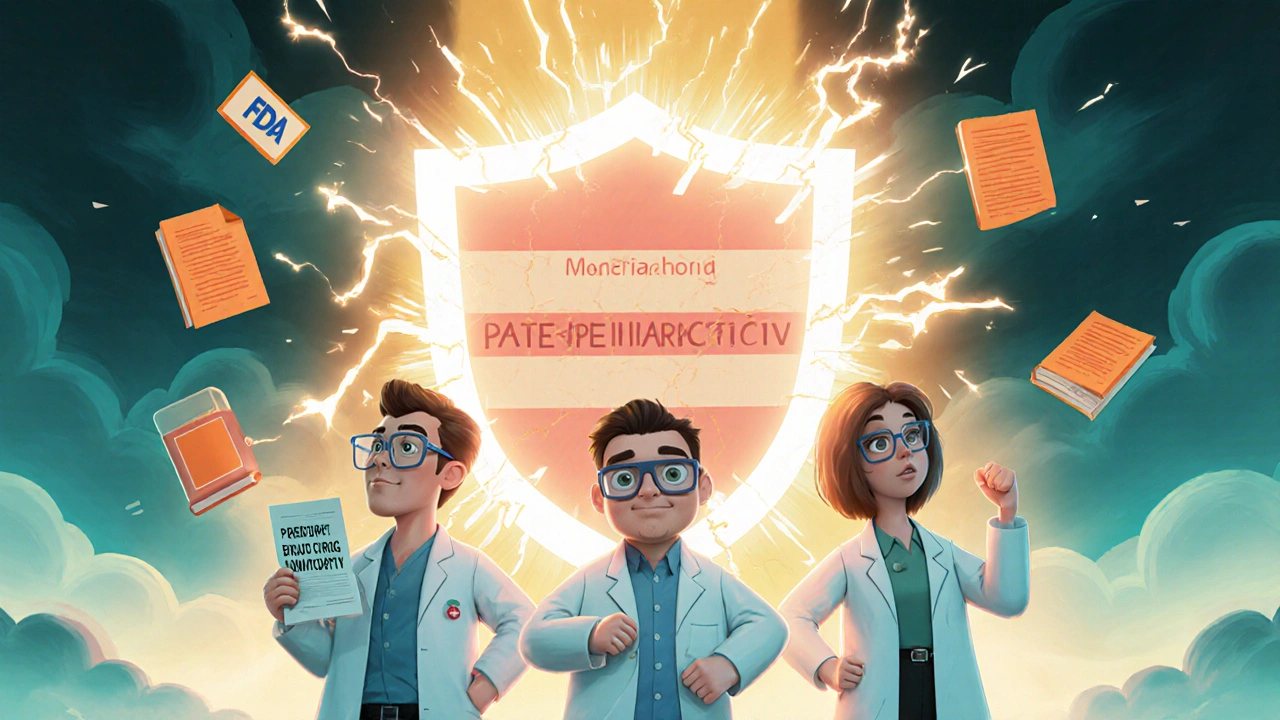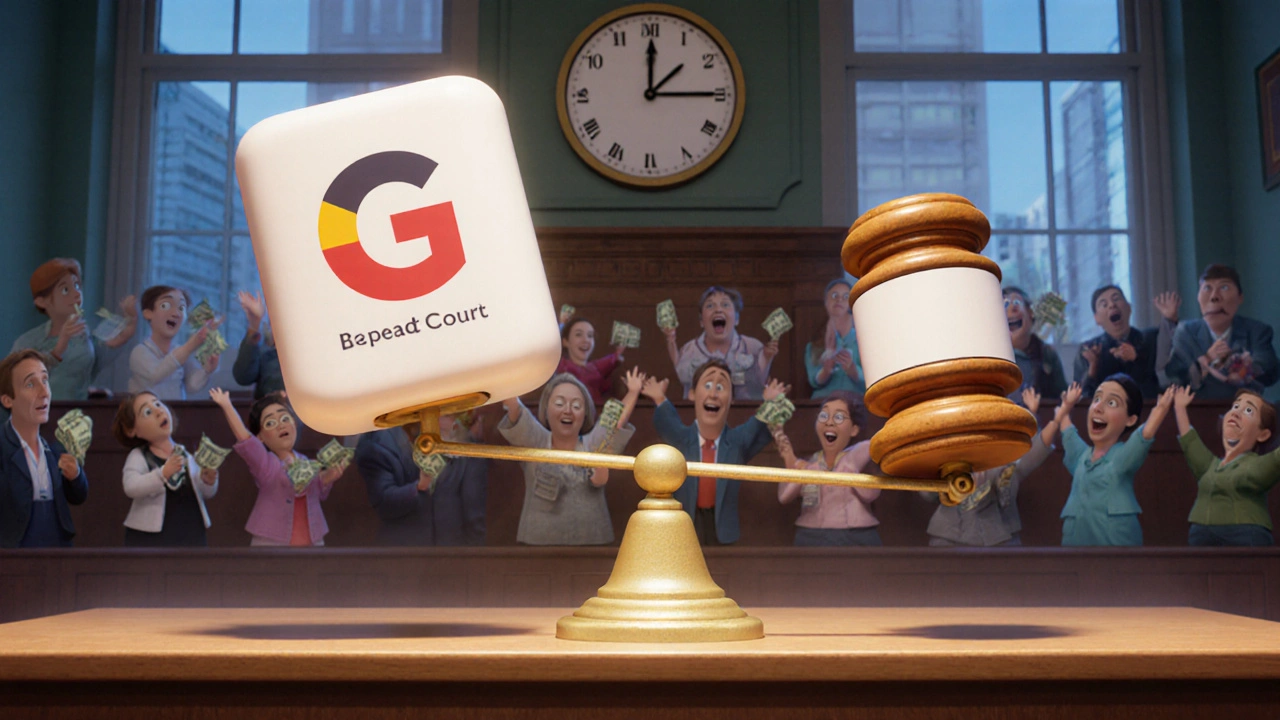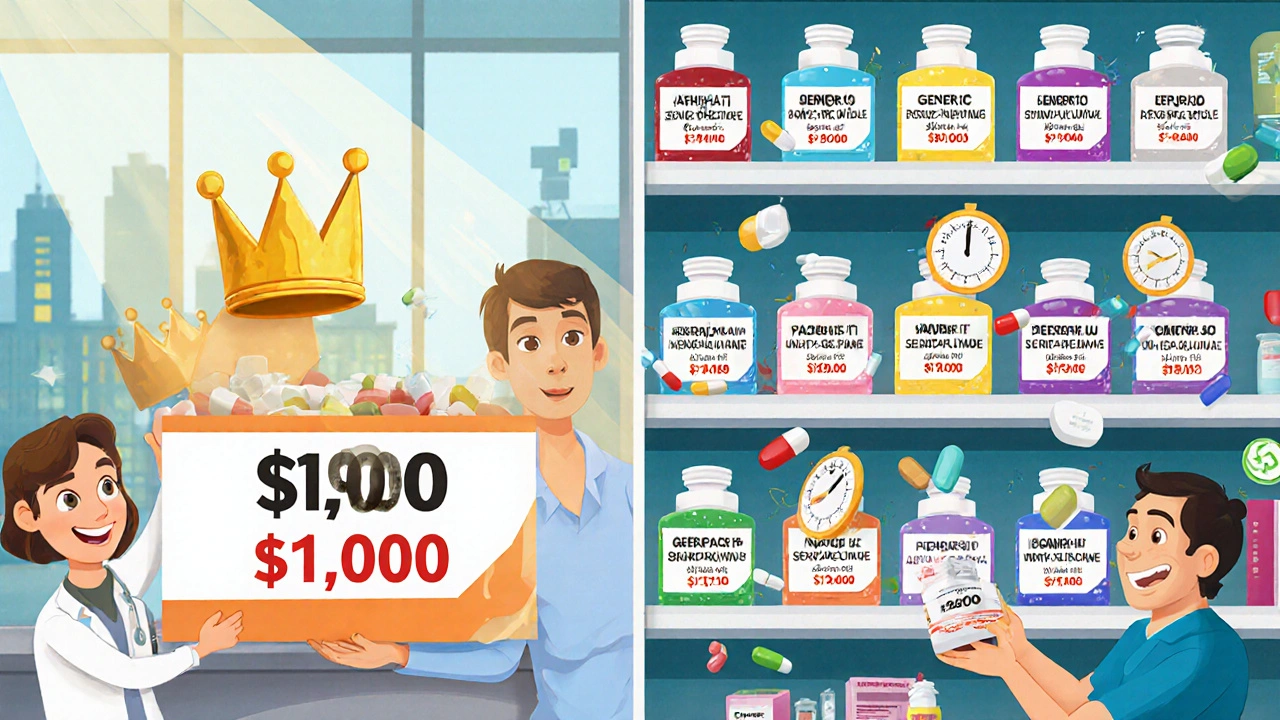Paragraph IV Certifications: How Generic Drug Companies Challenge Patents Before Launch
 Nov, 9 2025
Nov, 9 2025
When a brand-name drug hits the market, its patent gives the company a monopoly - often for 20 years. But that monopoly isn’t absolute. Behind the scenes, generic drug makers are quietly preparing to break it open. The tool they use? A legal maneuver called a Paragraph IV certification. It’s not a lawsuit. It’s not a protest. It’s a formal notice filed with the FDA that says: ‘Your patent is invalid, or we won’t infringe it - and we’re ready to sell our version now.’ This single step triggers a chain reaction that can slash drug prices by 80% within months.
How Paragraph IV Certifications Work
The process starts when a generic drug company files an Abbreviated New Drug Application (ANDA) with the FDA. Alongside that application, they submit a Paragraph IV certification. This isn’t just a checkbox. It’s a legal declaration under U.S. law (35 U.S.C. § 271(e)(2)) that one or more patents listed for the brand drug in the FDA’s Orange Book are either invalid, unenforceable, or won’t be infringed by their product.
Here’s the twist: under the Hatch-Waxman Act of 1984, submitting this certification is treated as an artificial act of patent infringement. That means the brand-name company doesn’t have to wait for the generic drug to hit shelves before suing. They can sue immediately. The generic company, in turn, gets a shot at being the first to market - and if they win, they get 180 days of exclusive sales rights before any other generic can enter.
The timeline is tight. Once the FDA accepts the ANDA, the generic manufacturer has just 20 days to notify the patent holder. The brand company then has 45 days to file a lawsuit. If they do, the FDA can’t approve the generic for 30 months - unless the court rules sooner. That’s the 30-month stay. It’s not a delay tactic by the FDA; it’s a legal pause built into the system to let courts sort out the patent dispute before the generic launches.
Why This System Exists
Before Hatch-Waxman, brand-name companies had little incentive to let generics in. They could sit on patents, delay approvals, and keep prices high. Generic companies had no clear path to challenge patents without risking massive lawsuits after launch - and if they lost, they’d owe millions in damages.
Paragraph IV changed that. It created a safe, structured way to resolve patent disputes before any product hits the market. It’s like a pre-emptive strike - but one governed by rules. The system balances two goals: protecting innovation by honoring patents, and promoting competition by letting generics challenge weak or overreaching ones.
It works. Since 1984, Paragraph IV certifications have helped bring generic versions of 90% of brand-name drugs to market. In 2024 alone, they saved U.S. consumers $192 billion. That’s not just a number - it’s insulin, blood pressure meds, and cancer drugs that millions can now afford.
The Strategy Behind the Challenge
Not every generic company files a Paragraph IV certification. It’s expensive, risky, and complex. On average, each challenge costs $12.3 million in legal fees and takes nearly 2.5 years to resolve. Companies don’t do it lightly.
They target drugs with high sales potential. A drug making $1 billion a year? If you’re the first generic to win, those 180 days of exclusivity could mean $500 million in pure profit. That’s why companies like Teva, Mylan, and Sandoz have dedicated teams of patent lawyers, pharmacologists, and regulatory experts just to handle these filings.
Successful challengers use smart tactics:
- Targeting drugs with only one or two patents - easier to defeat.
- Filing multiple Paragraph IV challenges against the same drug to pressure the brand company.
- Combining the challenge with a “skinny label” - selling the drug for only the non-patented uses. For example, if a drug treats three conditions but only one is patented, the generic can legally sell it for the other two.
According to industry data, about 37% of Paragraph IV filings use this “carve-out” strategy. It’s a legal gray zone, but it’s allowed - and it’s growing.

Brand Companies Fight Back
Brand-name drugmakers aren’t sitting still. They’ve responded with what critics call “patent thickets.” Instead of one or two patents, they now list an average of 17.3 patents per drug in the Orange Book - up from just 7.2 in 2005. Each patent is a new hurdle for generics to jump over.
They also use “product hopping” - making small changes to the drug (like switching from a pill to a liquid) and getting a new patent. This resets the clock and delays generics. In 2024, 31% of Paragraph IV targets were affected by this tactic.
And then there’s “pay-for-delay.” In 68% of Paragraph IV cases, the brand and generic companies settle - but not always fairly. In many of those settlements, the brand pays the generic to delay launching. The FTC calls this anti-competitive. In 2023 and 2024, they filed 17 lawsuits against these deals. One settlement in 2024 involved a $187 million payment to delay a generic version of a blockbuster drug by over two years.
Who Wins? Who Loses?
The winners are clear: patients and taxpayers. Generic drugs now make up 90% of all prescriptions in the U.S. - and Paragraph IV challenges are behind nearly half of those entries. The cost savings are staggering. A drug that costs $10,000 a year with a brand patent might drop to $2,000 within months of a generic launch.
But the losers are often the generic companies themselves. Even if they win, they spend millions and wait years. And if they lose? They’re out of pocket with nothing to show for it.
Some companies take “at-risk” launches - meaning they start selling before the court rules. In 2024, 22% of challengers did this. It’s high-stakes: if they lose, they could owe $200 million in damages. But if they win? They capture the market early. One company launched an at-risk generic for a heart drug and made $83 million in pre-ruling sales - before the court eventually sided with them.

The Future of Paragraph IV
The system is evolving. In October 2022, the FDA tightened rules around amending Paragraph IV certifications. Now, if a generic company changes the drug’s strength or crystalline structure after filing, they must update their certification - no more sneaky tweaks to avoid litigation.
And in 2025, new data shows generic companies are winning more often. Success rates jumped from 41% (2003-2019) to 58% (2020-2025). Why? Supreme Court rulings have made it harder to patent obvious or vague claims. Patents on minor drug modifications? More likely to be thrown out now.
Next up? The FDA is considering a 2026 rule that would force brand companies to justify every patent they list in the Orange Book. If passed, it could cut patent thickets by 30-40%. That’s good news for generics - and for patients waiting for affordable drugs.
Meanwhile, the FTC is stepping up enforcement. With more lawsuits against pay-for-delay deals, we may see generic drugs entering the market 4-6 months sooner on average. That’s not just a legal shift - it’s a health shift.
What This Means for You
If you’re on a prescription drug, Paragraph IV certifications are already working for you. They’re why your monthly pill costs $10 instead of $100. They’re why new generics appear every few months, even for expensive brand-name drugs.
But if you’re a patient with a chronic condition - diabetes, heart disease, autoimmune disorders - you’re not just benefiting from lower prices. You’re benefiting from a system designed to break monopolies, not protect them. That’s the quiet power of Paragraph IV: it lets competition enter through the back door of the law, and in doing so, it saves lives.
What is a Paragraph IV certification?
A Paragraph IV certification is a legal statement made by a generic drug company when filing an Abbreviated New Drug Application (ANDA). It declares that one or more patents listed for the brand-name drug in the FDA’s Orange Book are invalid, unenforceable, or will not be infringed by the generic product. This triggers the right to challenge the patent in court before the generic drug is sold.
How does Paragraph IV help lower drug prices?
Paragraph IV certifications allow generic manufacturers to enter the market faster by challenging weak or overreaching patents before launch. The first generic to successfully challenge a patent gets 180 days of exclusive sales, which drives competition. Once multiple generics enter, prices typically drop by 80-90%. Since 1984, this system has saved U.S. consumers over $2.2 trillion.
Why do brand companies list so many patents?
Brand companies list multiple patents - an average of 17.3 per drug in 2024 - to create a “patent thicket.” Each patent adds a legal barrier for generics to overcome. Even if one patent is invalidated, others may still block entry. This strategy, called evergreening, delays competition and extends monopoly pricing.
What is the 180-day exclusivity period?
The first generic company to successfully challenge a patent through a Paragraph IV certification gets 180 days of market exclusivity - meaning no other generic can launch during that time. This incentive encourages companies to take on expensive legal battles. For a blockbuster drug, that period can mean hundreds of millions in profit.
What are pay-for-delay settlements?
Pay-for-delay settlements occur when a brand-name drug company pays a generic manufacturer to delay launching its cheaper version. These deals are controversial and often anti-competitive. The FTC has sued 17 such agreements since 2023, arguing they keep drug prices high and harm consumers. In 2024, the average payment in these deals was $187 million.
Can a generic drug launch before the patent expires?
Yes - but only if the generic company files a Paragraph IV certification and wins the legal challenge. The FDA cannot approve the generic until the patent dispute is resolved. If the court rules the patent is invalid or not infringed, the generic can launch even before the patent technically expires. This is the core of the Hatch-Waxman Act’s design.
Jennifer Bedrosian
November 10, 2025 AT 23:03This is wild honestly like who even thought this up?? Like imagine being a drug company and just going ‘hey we’re gonna sue you before you even make the pill’ 😳 I mean that’s next level corporate warfare
Lashonda Rene
November 12, 2025 AT 10:45i never knew this whole system existed like at all and now i feel kinda dumb but also so much more informed?? like i’ve been taking generics for years and never thought about how they even got here like someone had to fight a whole legal battle just so i could afford my blood pressure med and now i’m crying a little
Andy Slack
November 12, 2025 AT 21:01That 180-day exclusivity window is the real MVP. Imagine being the first to crack open a $1B drug market and walking away with half a billion. That’s not business, that’s a lottery win with a law degree.
Rashmi Mohapatra
November 14, 2025 AT 00:19in india we dont have this system its all about who pays more to govt and fake patents and still people die because of price i mean how is this fair
Abigail Chrisma
November 15, 2025 AT 00:58This is one of those quiet systems that saves lives every single day. People don’t realize that behind every $10 generic pill is a team of lawyers, scientists, and risk-takers betting everything on a legal gamble. We should be talking about this more.
Ankit Yadav
November 16, 2025 AT 06:26It’s fascinating how the law created a space for competition instead of just letting monopolies win. The 30-month stay feels like a buffer so courts don’t rush, but honestly it’s still too long when people need meds now
Meghan Rose
November 16, 2025 AT 10:38Wait so if they launch ‘at-risk’ and lose they owe $200M? That’s insane. Who even has that kind of cash? These companies are basically gambling with people’s lives and insurance premiums. This system is broken if only billionaires can play.
Steve Phillips
November 17, 2025 AT 18:46Rachel Puno
November 18, 2025 AT 19:56My mom’s diabetes med dropped from $800 to $15 after a Paragraph IV challenge. I didn’t know the backstory until now. This isn’t just policy-it’s personal. Thank you for explaining it so clearly.
Clyde Verdin Jr
November 20, 2025 AT 05:43Oh please. The ‘180-day exclusivity’ is just a cartel loophole. First generic gets rich, then everyone else waits. That’s not competition-that’s a rigged game. And don’t even get me started on pay-for-delay. These companies are literally paying each other to keep prices high. 🤡
Cris Ceceris
November 21, 2025 AT 17:23It’s kind of poetic, right? The law doesn’t stop innovation-it just forces it to compete. The patent system was meant to reward creation, not stifle access. Paragraph IV is the system’s way of saying: ‘You built something great, but the world needs it too.’
Brad Seymour
November 22, 2025 AT 21:16Love this breakdown. I’m from the UK and we don’t have this exact system, but the principle is the same. If we could replicate this model globally, imagine how many lives we could save. It’s not just about money-it’s about dignity.
Malia Blom
November 24, 2025 AT 01:08So you’re telling me that a company can literally change a pill’s color or make it a liquid and get a NEW patent? That’s not innovation-that’s a magic trick. And we call this capitalism? More like legal fiction with a side of greed.
Erika Puhan
November 24, 2025 AT 07:17The 58% success rate since 2020 is statistically significant, but the underlying structural issues remain unaddressed. The Orange Book’s patent listing requirements are fundamentally flawed and lack enforceable verifiability thresholds. This is regulatory capture at its finest.
Steve Phillips
November 25, 2025 AT 07:37And don’t even get me started on the fact that the FDA’s own guidelines are being ignored by Big Pharma… they’re gaming the system with ‘skinny labels’ and ‘evergreening’ like it’s a video game cheat code. This isn’t healthcare-it’s a corporate heist with a white coat.